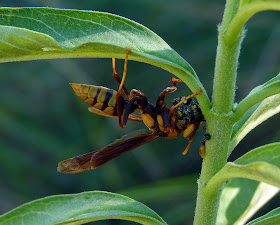 Seeing one creature attack and devour another is never easy, no matter the size. Whether it's an egret gobbling up a lizard, or a hawk snatching duckling from under its mother's beak, the circle of life is disturbing... and fascinating.
Seeing one creature attack and devour another is never easy, no matter the size. Whether it's an egret gobbling up a lizard, or a hawk snatching duckling from under its mother's beak, the circle of life is disturbing... and fascinating.Today's featured predator is the paper wasp. Wasps are a beneficial insect in the garden, keeping other insects in control, especially flies and caterpillars. This is all well and good, unless of course you happen to like caterpillars, in which case it can be a little demoralizing to watch wasps picking them off one by one.
The paper wasp below was finishing up a monarch caterpillar feast when we found him. He'd made a bit of a mess, and was surrounded by partially digested milkweed from the caterpillar's gut.
You can easily see that this was once a monarch caterpillar - the yellow and black stripes are still present, along with the long black tubercules from its head.
Though this seems to be a gruesome sight, there's a softer side to the story. Adult wasps get their own sustenance from nectar. When they feed on caterpillars, what they're really doing is storing up food to take back to the nest, where they'll regurgitate the partially-digested caterpillar to feed the wasp larvae.
So, the wasps won this battle. However, on milkweed nearby, we spotted at least 5 other nearly full-grown monarch caterpillars, and dozens of eggs. The wasps are just filling their part in the circle, keeping caterpillar and butterfly populations in check. Nature is a delicate balance, and My Florida Backyard is glad to be part of the scales.
Note: While wasps can be aggressive, this one was too busy chowing down to be concerned with our camera. Still, you should always take precautions around wasps of any kind; you never know when they might turn on you.



This was an interesting post. I didn't realize they ate caterpillars.
ReplyDeleteFlowerLady